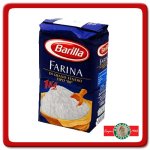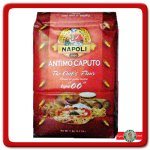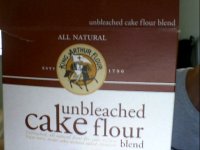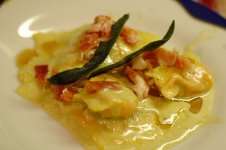heres a different concept with sublime melt in your mouth results
http://smittenkitchen.com/2008/02/seven-yolk-pasta-dough/
http://www.epicurious.com/recipes/food/views/Pasta-Dough-for-Agnolotti-105858
http://www.athoughtforfood.net/2010/10/recipe-seven-yolk-pasta-dough/
Seven-Yolk Pasta Dough and Sweet Potato Agnolotti with Brown-Butter Sauce and Prosciutto di Parma
Seven-Yolk Pasta Dough
from Thomas Kellers French Laundry Cookbook
Ingredients:
1 3/4 cups (8 ounces) all-purpose flour
6 large egg yolks
1 large egg
1 1/2 teaspoons olive oil
1 tablespoon milk
Directions:
Mound flour on a board or in a bowl and create a well in the center, pushing the flour to all sides to make a ring with sides about 1-inch wide. Make sure that the well is wide enough to hold all the eggs without spilling.
Pour the egg yolks, egg, oil and milk into the well. Use your fingers to break the eggs up. Still using your fingers, begin turning the eggs in a circular motion, keeping them within the well and not allowing them to spill over the sides. This circular motion allows the eggs to gradually pull in flour from the sides of the well; it is important that the flour not be incorporated too rapidly, or dough will be lumpy. Keep moving the eggs while slowly incorporating the flour. Occasionally push the flour toward the eggs; the flour should be moved only enough to maintain the gradual incorporation of the flour, and the eggs should continue to be contained within the well. The mixture will thicken and eventually get too tight to keep turning with your fingers.
When the dough begins thickening and starts lifting itself from the board, begin incorporating the remaining flour by lifting the flour up and over the dough that’s beginning to form and cutting it into the dough. When the remaining flour from the sides of the well has been cut into the dough, the dough will still look shaggy. Bring the dough together with the palms of your hands and form it into a ball. It will look flaky but will hold together.
Knead the dough by pressing it, bit by bit, in a forward motion with the heels of your hands rather than folding it over on itself as you would with a bread dough. Re-form the dough into a ball and repeat the process several times. The dough should feel moist but not sticky. Let the dough rest for a few minutes while you clean the work surface.
Dust the clean work surface with a little flour. Knead the dough by pushing against it in a forward motion with the heels of your hands. Form the dough into a ball again and knead it again. Keep kneading in this forward motion until the dough becomes silky smooth. The dough is ready when you can pull your finger through it and the dough wants to snap back into place. The kneading process can take from 10 to 15 minutes.
Even if you think you are finished kneading, knead it for an extra 10 minutes; you cannot overknead this dough. It is important to work the dough long enough to pass the pull test; otherwise, when it rests, it will collapse.
Double-wrap the dough in plastic wrap to ensure that it does not dry out. Let the dough rest for at least 30 minutes and up to 1 hour before rolling it through a pasta machine. The dough can be made a day ahead, wrapped and refrigerated; bring to room temperature before proceeding.
Use 1/2 recipe pasta dough, divided into two or three pieces. Run the dough through a pasta machine as for ravioli, but make the sheets wider. The size will vary according to the pasta machine used, but the sheets should be at least five inches wide. It is important that your pasta sheet be thin enough so that you can see your fingers through it, but not so thin that it's translucent. Keep the pasta sheets covered, as they dry out quicklyand proceed with filling the agnolotti.
To fill agnolotti:
If you are planning on using the agnolotti immediately, have a large pot of lightly salted boiling water ready. Work with one sheet of pasta at a time, keeping the remaining sheets covered. Work quickly, as fresh pasta will dry out.
Lay the pasta sheet on a lightly floured surface with a long side facing you. Trim the edges so they are straight. Place the agnolotti filling in a pastry bag fitted with a 1/2-inch plain tip. Pipe a "tube" of filling across the bottom of the pasta sheet, leaving a 3/4-inch border of pasta along the left, right and bottom edges.
Pull the bottom edge of the pasta up and over the filling. Seal the agnolotti by carefully molding the pasta over the filling and pressing lightly with your index finger to seal the edge of the dough to the pasta sheet; don't drag your finger along the dough to seal, or you risk ripping the dough. When it is sealed, there should be about 1/2 inch of excess dough visible along the tube of filling (where you sealed it). Be certain that you are sealing tightly while pressing out any pockets of air. Seal the left and right ends of the dough.
To shape agnolotti:
Starting at one end, place the thumb and forefinger of each hand together as if you were going to pinch something and, leaving about 1 inch of space between your hands and holding your fingers vertically, pinch the filling in 1-inch increments, making about 3/4 inch of "pinched" are between each pocket of filling. It is important to leave this much "pinched" area between the agnolotti, or when the agnolotti are separated, they may come unsealed.
Run a crimped pastry wheel along the top edge of the folded-over dough, separating the strip of filled pockets from the remainder of the pasta sheet. Don't cut too close to the filling, or you risk breaking the seal. Separate the individual agnolotti by cutting the center of each pinched area, rolling the pastry wheel away from you. Working quickly, place the agnolotti on a baking sheet dusted with a thin layer of cornmeal, which will help prevent sticking. Don't let the agnolotti touch each other, or they may stick together.
Repeat the same procedure on the remainder of your pasta sheets. Either cook the agnolotti immediately in the boiling water, or place the baking sheet in the freezer. Once the agnolotti are frozen, place them in airtight freezer bags and keep them frozen for up to several weeks. Cook the agnolotti while still frozen.
Sweet Potato Agnolotti {extra thin delicate Ravioli} with Sage Cream, Brown Butter, and Prosciutto
from Thomas Kellers French Laundry Cookbook
Ingredients:
1 1/2 pounds of sweet potatoes
8 tablespoons (4 ounces) unsalted butter
2 slices bacon, frozen and cut into 1/4-inch dice
Pinch of allspice and nutmeg
Kosher salt and freshly ground black pepper
For the Sage Cream:
1/3 cup sage leaves (from about 4 bunches; use the smaller leaves for the fried sage leaf garnish)
1 cup creme fraiche
1cup Beurre Monte
To finish:
Ghee or oil for deep-frying
48 tiny sage leaves (reserved from above)
2 tablespoons (1 ounce) unsalted butter
4 thin slices of prosciutto, cut crosswise into fine julienne
To make the Beurre Monte:
Thomas Keller describes Beurre Monte sauce as a workhorse sauce and many of his recipes include it. Whether you emulsify 4 tablespoons or 1 pound of butter, just a tablespoon of water will do. Any amount of Beurre Monte can be made using the following method.
Bring the tablespoon of water to a boil in a saucepan. Reduce the heat to low and begin whisking the chunks of butter into the water, bit by bit, to emulsify. Once you have established the emulsion, you can continue to add pieces of butter until you have the quantity of beurre monte that you need (1 cup). It is important to keep the level of heat gentle and consistent in order to maintain the emulsification. Make Beurre Monte close to the time it will be used and keep it in a warm place.
To make the Sweet Potato filling:
Preheat the oven to 350 degrees. Cut the ends off the potatoes and wrap the potatoes individually in aluminum foil, dividing 4 tablespoons of butter evenly among them. Bake until they are soft, 1 to 2 hours (the time will vary, depending on the size of the potatoes). Unwrap the cooked potatoes and cut a slit lengthwise in the skin of each. Pull the skin away from the potato and discard. Push the potatoes through a potato ricer while they are hot and place in a saucepan.
Place the diced bacon in a skillet. Cook until it is lightly browned and the fat has been rendered. Transfer the bacon pieces to paper towels to drain briefly, then add them to the potatoes.
Stir the potatoes over low heat, seasoning to taste with the squab spice and salt and pepper. Mix in the remaining 4 tablespoons butter. You will have about 1 2/3 cups filling (enough to fill 35 – 40 ravioli). Refrigerate the filling until chilled, or for up to 2 days, before filling the ravioli.
To make the pasta:
Make fresh pasta. Divide the pasta dough into three pieces. Set the rollers of the pasta machine at the widest setting. Take one third of the finished pasta dough, almost 5 ounces, and cut it in half. Run the dough through the pasta machine. Fold the dough in half, end to end, turn it a quarter turn, and run it through the same setting again. Repeat this procedure two more times. Set the openings of the rollers down one notch and run the pasta through. Decrease the opening another notch and run the dough through again. Continue this process until the second to last setting. Repeat with the remaining 5 sections of pasta dough.
Dust a wooden work surface with flour. I use a large ravioli press to make my ravioli. If you don’t have a press follow these instructions. Place a sheet of pasta dough on a lightly floured surface. Brush the surface of the dough with egg wash. Mark (don’t cut) 12 circles in the dough with the dull side of a 2-inch round cutter, leaving at least 1/2 inch between them. Center 1 tablespoon of the sweet potato filling in a mound on each circle. Line up one end of a second sheet of dough along one end of the dough and carefully drape the pasta sheet over the filling, pressing down between the mounds of filling. Run you fingers around each mound of the filling to press out any air bubbles. Using a 2 1/4 – inch round cutter, cut out the 12 ravioli. Using a fork, carefully press the edges of the rounds together to secure the filling inside. Line a baking sheet with parchment paper, lightly dust it with flour, and place the finished ravioli on it. Repeat this process with the remaining pasta sheets. If the ravioli are to be used within a few hours cover the baking sheet lightly and refrigerate.
To make the sage cream:
Blanch the 1/3 cup of sage leaves in boiling water for 2 minutes. Drain, cool in cold water, and drain again. Squeeze the leaves dry. Heat the creme fraiche, beurre monte, and salt over low heat until hot; do not boil. Place the sage in a blender to chop it. With the motor running, pour the hot cream mixture through the top of the blender and blend thoroughly. Strain the cream into a large skillet, season with salt and pepper to taste, and set aside.
To complete:
In a small sauce pan, heat oil for deep-frying to 275 degrees. Fry the sage leaves briefly, just until they are crisp (their color should not change), and drain on paper towels. Place the butter in a skillet over medium heat and cook to a nutty brown color; reduce the heat and keep warm.
Meanwhile cook the ravioli in a large pot of lightly salted boiling water until cooked through, 4 to 5 minutes. Drain the cooked ravioli and mix them gently with the sage cream. Divide the ravioli among 6 serving dishes and drizzle with browned butter. Scatter some prosciutto over each serving and garnish with the fried sage leaves.
http://baileysbarkery.wordpress.com...-with-sage-cream-brown-butter-and-prosciutto/
http://flinbk.blogspot.com/2010/01/chestnut-agnolotti-with-sage-cream.html





















